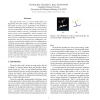Free Online Productivity Tools
i2Speak
i2Symbol
i2OCR
iTex2Img
iWeb2Print
iWeb2Shot
i2Type
iPdf2Split
iPdf2Merge
i2Bopomofo
i2Arabic
i2Style
i2Image
i2PDF
iLatex2Rtf
Sci2ools
110
Voted
ICCV
2005
IEEE
2005
IEEE
Recovering Human Body Configurations Using Pairwise Constraints between Parts
The goal of this work is to recover human body configurations from static images. Without assuming a priori knowledge of scale, pose or appearance, this problem is extremely challenging and demands the use of all possible sources of information. We develop a framework which can incorporate arbitrary pairwise constraints between body parts, such as scale compatibility, relative position, symmetry of clothing and smooth contour connections between parts. We detect candidate body parts from bottom-up using parallelism, and use various pairwise configuration constraints to assemble them together into body configurations. To find the most probable configuration, we solve an Integer Quadratic Programming problem with a standard technique using linear approximations. Approximate IQP allows us to incorporate much more information than the traditional dynamic programming and remains computationally efficient. 15 hand-labeled images are used to train the low-level part detector and learn the pa...
Arbitrary Pairwise Constraints | Candidate Body Parts | Computer Vision | Human Body Configurations | ICCV 2005 | Pairwise Configuration Constraints | Quadratic Programming Problem |
Related Content
| Added | 15 Oct 2009 |
| Updated | 15 Oct 2009 |
| Type | Conference |
| Year | 2005 |
| Where | ICCV |
| Authors | Xiaofeng Ren, Alexander C. Berg, Jitendra Malik |
Comments (0)

